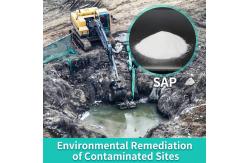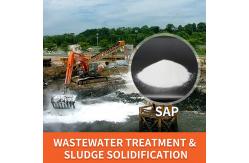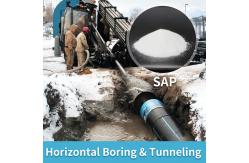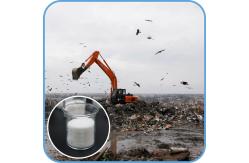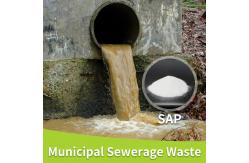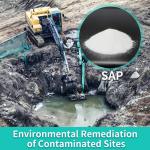No Leakage Sap Super Absorbent Polymer 9003-04-7 sludge solidification polymer
|
MACRO SORB ® Sludge and Wastewater Solidification Polymer Less Expansion High Liquid Retention No LeakageIntroduction of MACRO SORB® Sludge and Wastewater Solidification PolymerMACRO SORB® SLUSORB Polymer is the high-efficient, cost-effective & eco-friendly choice for liquid waste treatment. You only need a small amount of it (usually 1% of the waste) to treat bulk liquid waste. The gel formed after absorption can firmly lock the water and prevent the liquid waste from leaking even under certain pressure, the volume expansion rate is less than 1%, which can reduce transportation and processing costs.
MACRO SORB® Sludge and Wastewater Solidification Polymer Advantages
MACRO SORB® SLUSORB Polymer is extensively utilized to capture and immobilize free liquids, ensuring that waste complies with the Paint Filter Test (EPA 9095) for No Free Liquids. The hazardous liquids are securely trapped within the polymer matrix, preventing the release of harmful substances into the surrounding environment. This method simplifies the management of liquid waste, whether from spills or excess materials. Once treated, the waste can be safely transported and disposed of in a certified, engineered landfill. Core Value Proposition1. Operational Efficiency Enhancement lRapid Solidification: Instant absorption of water/organic fluids, reducing mixing time by ≥50% vs. traditional solidifiers lEquipment Compatibility: Direct handling with standard excavators/trucks, eliminating specialized equipment costs lLabor Optimization: Streamlines onsite workflows and mitigates labor-intensive risks 2. Lifecycle Cost Reduction lWaste Volume Compression: <1% expansion rate, decreasing transportation frequency by 90%+ lDisposal Cost Savings: 35-60% reduction in total disposal fees through dual weight/volume reduction lStorage Flexibility: Complies with non-hazardous landfill standards, minimizing specialized storage needs 3. ESG Performance Advancement lContaminant Sequestration: Immobilizes heavy metals, hydrocarbons, and pollutants to prevent environmental leakage lCircular Economy Integration: Compatible with industrial byproducts (slag, fly ash, etc.) to support resource recovery lCarbon Footprint Reduction: Dual impact via transport emission cuts and energy conservation, aligning with net-zero goals
Applications of SAPs in Sludge and Wastewater ManagementIndustrial Waste ManagementSuperabsorbent Polymers (SAPs) are widely employed in industrial environments to solidify diverse forms of waste sludge, including wastewater treatment residues, industrial process slurries, and contaminated soils. This application enhances waste handling efficiency and supports environmental compliance. Construction and Demolition WasteIn construction and demolition projects, SAPs are utilized to solidify slurry produced during activities such as concrete cutting, drilling, and structural dismantling. This process simplifies waste management, reduces disposal costs, and minimizes environmental impact. Oil & Gas IndustrySAPs are instrumental in the oil and gas sector for solidifying drilling muds and sludges. By transforming these materials into manageable solids, SAPs improve waste handling practices, reduce operational risks, and support sustainable drilling operations. Municipal Solid WasteMunicipalities leverage SAPs to solidify organic waste sludge, sewage slurry, and landfill leachate. This application not only streamlines landfill management but also effectively controls odors, contributing to cleaner and more efficient waste processing systems. FAQ1. What is sludge & wastewater solidification polymer? Sludge and wastewater solidification polymer is a specialized chemical formulation designed to bind and solidify liquid sludge, wastewater, or other liquid waste materials into a solid, manageable form. This process simplifies disposal, reduces environmental impact, and improves handling efficiency. 2. How does the solidification polymer work? The polymer works by absorbing water molecules and forming a gel-like structure that binds solid particles together. This reaction transforms liquid or semi-liquid waste into a solid mass, making it easier to transport, dispose of, or repurpose. 3. Is the polymer cost-effective? Yes, the polymer is highly cost-effective due to its high efficiency and ability to treat large volumes of waste with minimal product usage. It also reduces disposal costs by converting liquid waste into solid form, which is often cheaper to transport and dispose of.
4. How long does the solidification process take? The solidification process typically begins within minutes of application, with complete solidification occurring within a few hours. The exact time depends on factors such as waste composition, temperature, and polymer dosage. |
||||||||||||||||||||||||||||||||||||||||
| Product Tags: No Leakage Sap Super Absorbent Polymer 9003-04-7 sludge treatment polymer 9003-04-7 sludge solidification polymer |

